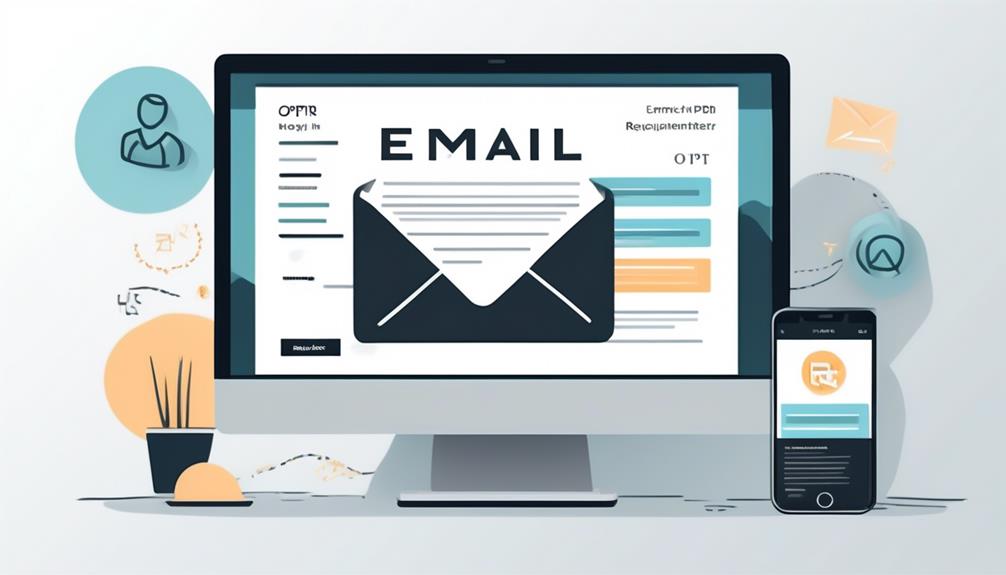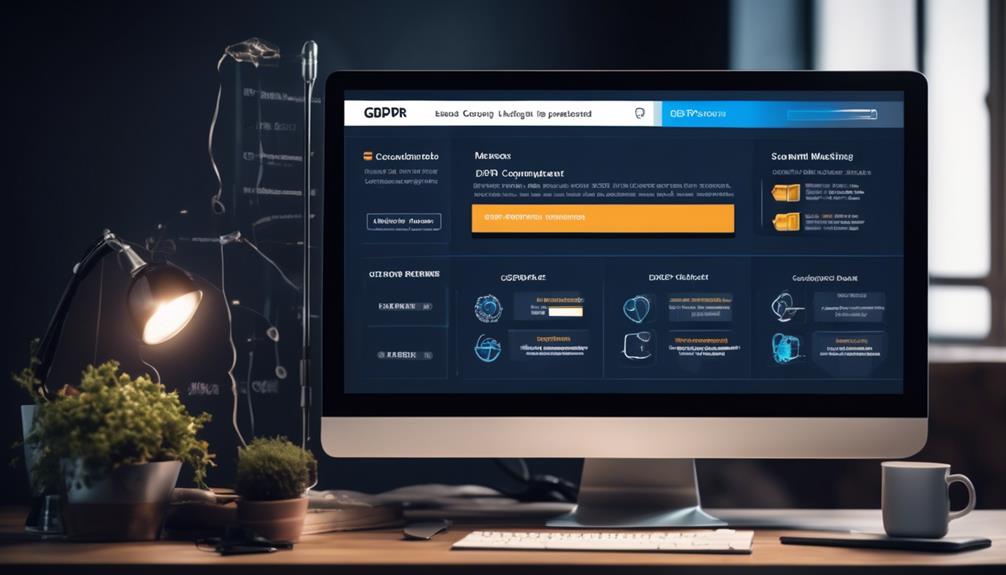Navigating the complexities of GDPR compliance in email marketing can be likened to maneuvering through a labyrinth of rules and obligations. It is crucial for businesses to grasp the four essential steps for GDPR-compliant email marketing in order to steer clear of possible pitfalls and ensure their marketing endeavors adhere to the legal requirements.
From obtaining lawful consent to managing subscriber data, these steps are crucial for businesses aiming to build a solid foundation for their email marketing strategies in the era of GDPR.
Key Takeaways
- GDPR significantly impacts the regulation of marketing emails, as sending a marketing email now constitutes the processing of personal data.
- Under GDPR, there are two lawful bases for marketing: consent and legitimate interests. However, legitimate interest does not work for marketing emails, making consent mandatory.
- Obtaining lawful consent for email marketing must meet GDPR criteria, including being freely given, specific, informed, and unambiguous.
- Managing subscriber data requires establishing clear processes for regular review and updates of email databases, differentiating between individuals who have provided lawful consent and those who have not, and honoring data subject rights such as the right to unsubscribe.
Understanding GDPR Requirements
Understanding the GDPR requirements is crucial for ensuring compliance with the regulations governing email marketing in the European Union. The GDPR has significantly impacted how marketing emails are regulated, as the act of sending a marketing email now constitutes the processing of personal data.
Under the GDPR, there are two lawful bases for marketing, namely consent and legitimate interests. However, legitimate interest doesn't work for marketing emails, making consent a mandatory requirement.
To ensure GDPR compliance for marketing emails, it's essential to establish the rights to send marketing emails to the current database and obtain GDPR quality consent if it's lacking or unclear.
Additionally, the impending ePrivacy Regulation, set to replace the Privacy and Electronic Communications Regulations (PECR), has caused confusion due to its delayed implementation, emphasizing the need to stay updated on any changes or developments.
Non-compliance with GDPR for email marketing can lead to severe consequences, including legal claims, regulatory actions, and reputational damage, highlighting the paramount importance of compliance with the GDPR requirements for email marketing.
Therefore, effective consent management and staying abreast of GDPR and ePrivacy Regulation updates are integral to ensuring GDPR-compliant email marketing.
Obtaining Lawful Consent

Transitioning from the previous discussion on GDPR requirements, the process of obtaining lawful consent for email marketing under the GDPR is a critical aspect that necessitates clear understanding and meticulous adherence to the regulations. When obtaining consent for email marketing, it's imperative to ensure that it meets the GDPR criteria.
This means that consent must be freely given, specific, informed, and unambiguous, requiring clear affirmative action. It's crucial to regularly review and update email databases to maintain compliance with the GDPR and to consider the implications of the upcoming ePrivacy Regulation on obtaining lawful consent.
Understanding the consequences of non-compliance with GDPR for email marketing emphasizes the need for GDPR-quality consent. Failing to adhere to the regulations can result in severe penalties, making it essential to prioritize lawful consent in email marketing practices.
Additionally, it's important to consider the privacy rights of individuals and the protection of their personal data when obtaining consent for email marketing under the GDPR. By ensuring that consent is obtained in a manner that aligns with GDPR requirements, organizations can engage in GDPR-compliant email marketing while respecting privacy rights and data protection regulations.
Managing Subscriber Data
To effectively manage subscriber data for email marketing under GDPR compliance, it's crucial to establish and maintain clear processes for regular review and updates of email databases. This ensures that personal data is accurate and up to date, and that individuals who haven't given consent aren't included in marketing communications.
It's important to differentiate between individuals who've provided lawful consent and those who've not, as well as to have mechanisms in place to honor data subject rights, such as the right to unsubscribe. By creating separate marketing databases for 'soft opt-in' and GDPR quality consent, organizations can effectively manage subscriber data while respecting individuals' privacy preferences.
Additionally, providing clear options for individuals to opt-out or unsubscribe from marketing emails, such as including an unsubscribe link in every communication, is crucial for managing subscriber data in accordance with GDPR requirements. These measures demonstrate a commitment to data protection and privacy, aligning with the principles of legitimate interest and the organization's privacy policy.
Implementing Compliance Measures

Implementing compliance measures for GDPR-compliant email marketing requires a comprehensive approach to ensure adherence to data protection regulations and privacy standards. It's crucial to establish the lawful bases for processing personal data, such as obtaining explicit consent or relying on legitimate interest, in accordance with the General Data Protection Regulation (GDPR).
Regularly reviewing and updating email databases is essential to maintain compliance with the GDPR. Staying updated on changes or developments regarding the ePrivacy Regulation is necessary to ensure compliance with evolving standards.
Additionally, providing individuals with clear options to opt-out or unsubscribe from marketing emails is a fundamental requirement to comply with GDPR. Updating the privacy policy to clearly explain how personal data is used for marketing and how individuals can opt-out is essential to ensure compliance with the regulation.
It's imperative to establish the rights to send marketing emails to your current database and ensure that GDPR-quality consent is obtained. By incorporating these measures into email marketing practices, businesses can ensure compliance with GDPR and demonstrate a commitment to protecting individuals' privacy rights.
Frequently Asked Questions
How Do I Comply With GDPR Email Marketing?
To comply with GDPR email marketing, we prioritize obtaining GDPR-quality consent for sending marketing emails. We regularly review and update our email databases to ensure compliance.
Staying informed about changes in the ePrivacy Regulation is crucial, and we consider obtaining GDPR-quality consent from all individuals to comply.
Non-compliance can lead to severe consequences, including legal claims, regulatory actions, and financial penalties, emphasizing the importance of adhering to GDPR guidelines.
What Are the 7 GDPR Requirements?
We abide by the GDPR, which mandates seven key requirements. These include obtaining explicit consent for personal data processing, ensuring transparency and fairness in data usage, and allowing individuals to exercise their rights regarding their data.
Compliance necessitates clear, informed consent for email marketing activities, implying that legitimate interests alone are insufficient. The GDPR emphasizes the importance of explicit, affirmative action when obtaining consent, which is crucial for ensuring compliance in email marketing endeavors.
What Is the GDPR Fine for Email Marketing?
Oh, the GDPR fine for email marketing violations can be hefty, reaching as high as €20 million or 4% of the company's global turnover.
This serves as a stark reminder of the importance of compliance with GDPR consent and data processing requirements.
It's crucial for businesses to prioritize obtaining clear and specific consent for sending marketing emails to avoid such substantial fines.
What Are the Steps of Gdpr?
To comply with GDPR, we establish lawful bases for processing personal data, such as consent or legitimate interests.
We obtain high-quality consent for marketing emails, update privacy policies, and manage email databases with clear opt-out options.
Non-compliance can result in severe penalties and reputational damage.
It's crucial to prioritize compliance with GDPR regulations to mitigate risks and maintain trust with customers.
How Can I Ensure GDPR Compliance in Email Marketing?
Ensuring GDPR compliance in email marketing is crucial, so here are some gdpr compliance email marketing tips to remember. Obtain clear consent before sending any marketing emails, provide an easy opt-out option, always include your business information, and regularly update your subscriber list to remove inactive contacts.
Conclusion
In conclusion, ensuring GDPR-compliant email marketing requires careful attention to detail and a proactive approach to obtaining lawful consent and managing subscriber data.
It's like navigating a complex maze, where one wrong turn can lead to consequences.
By understanding the GDPR requirements, obtaining lawful consent, managing subscriber data, and implementing compliance measures, businesses can navigate the maze successfully and avoid the pitfalls of non-compliance.









